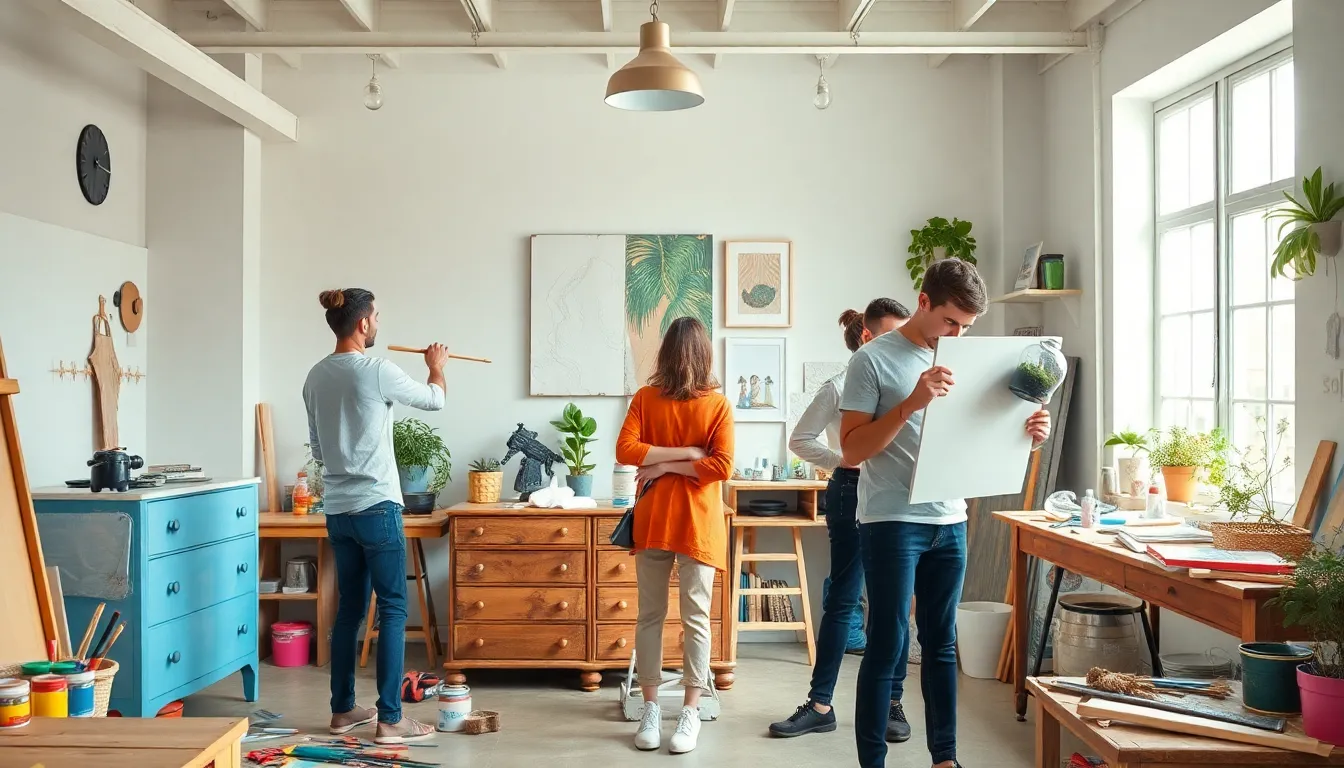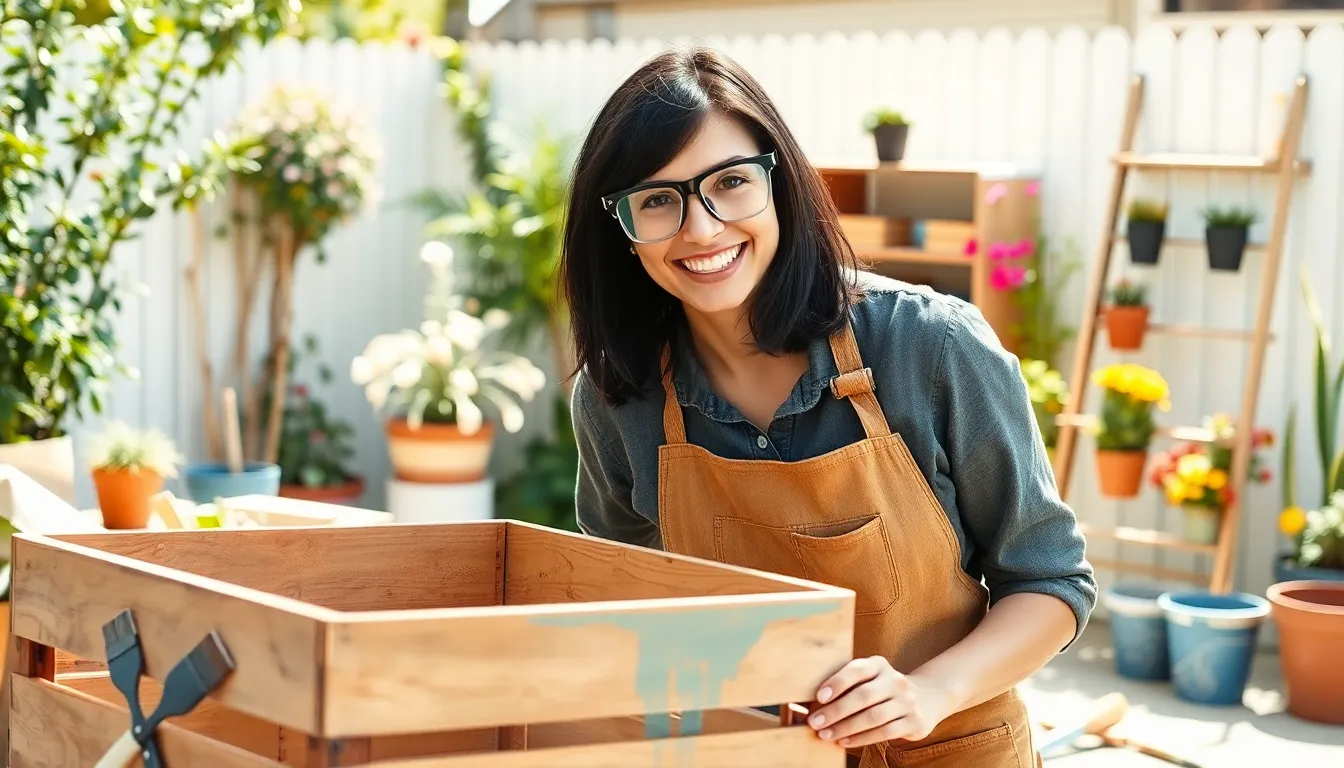Table of Contents
ToggleLooking to transform your space without breaking the bank? DIY design projects are the perfect way to unleash creativity while keeping those pesky dollars in your pocket. Whether it’s turning an old ladder into a chic bookshelf or giving that sad-looking chair a stylish makeover, the possibilities are endless.
Not only do these projects allow for personal expression, but they also provide a sense of accomplishment that no store-bought item can match. Plus, who doesn’t love the thrill of saying, “Oh, this? I made it myself!” So grab your tools and get ready to dive into a world where imagination meets practicality. With a little effort and a dash of humor, your home can become a masterpiece that reflects your unique style.
Overview of DIY Design Projects
DIY design projects offer individuals a hands-on approach to home improvement. Creative possibilities abound, including refurbishing furniture or creating new decor items. By repurposing everyday materials, one can minimize waste while maximizing creativity. Transforming an old ladder into a bookshelf showcases resourcefulness and personal flair.
Many find joy in the process of crafting. Personal satisfaction often arises from seeing a project come to life. Simple projects like painting a room or creating wall art can significantly enhance a space. Engaging in DIY also fosters a sense of community when sharing ideas and successes with others.
Budget-friendly options appeal to those looking to improve their homes without excessive spending. Various tutorials and resources are readily available online, making it easier than ever to get started. Emphasizing uniqueness, DIY projects allow individuals to reflect their personal style in ways store-bought items cannot replicate.
Flexibility characterizes DIY endeavors, as projects can range from small decorative items to larger structural changes. Taking on multiple projects simultaneously showcases creativity and keeps the momentum going. Enthusiasts often find that their skills improve with practice, leading to more ambitious designs over time.
Embracing DIY design projects transforms spaces and nurtures creativity. Individuals become empowered through the process, cultivating a distinctive home environment. Each project stands as a testament to creativity, resourcefulness, and personal achievement.
Popular DIY Design Projects

DIY design projects offer endless opportunities for creativity and personalization. Various projects cater to different skills and styles, making it easy for anyone to get involved.
Home Décor
Creating unique home décor items enhances the ambiance of any space. Wall art, such as canvas paintings or framed photography, adds character and reflects individual tastes. Additionally, handcrafted decorative pillows or throws provide comfort and color. Custom plant holders or terrariums contribute to a room’s liveliness, while repurposed jars can serve as chic vases. Utilizing everyday materials fosters creativity and helps individuals design personalized accents that stand out.
Furniture Upcycling
Furniture upcycling transforms old pieces into stunning focal points. Sanding and repainting a dresser can revitalize its look, while reupholstering chairs offers a fresh perspective. Transforming a vintage trunk into a coffee table combines functionality with style. Updating hardware on cabinets gives them a modern touch, and adding new legs to an old table can elevate its profile. Such projects not only breathe new life into furniture but also allow individuals to express their artistic vision.
Tools and Materials Needed
Choosing the right tools and materials sets the foundation for successful DIY design projects. Essential items streamline the process and ensure high-quality results.
Essential Tools
Basic tools include a tape measure, screwdriver, and level. Many projects also require a hammer and a utility knife. A drill enhances efficiency when creating holes or driving screws. Consider adding pliers and scissors for added versatility. Safety glasses protect eyes during cutting or drilling tasks. A paintbrush and roller will aid in applying finishes consistently. Leveling tools ensure even results, especially for wall-mounted items. Storing tools in a toolbox or organizer simplifies accessibility. Using the right tools minimizes errors while increasing satisfaction in the finished product.
Recommended Materials
Wood offers versatility for furniture and decor items. Paint transforms surfaces, allowing for endless color options. Fabric plays a key role in upholstery or creating custom curtains. Adhesives secure parts together, with hot glue or wood glue being common choices. Sandpaper smooths rough edges, ensuring a professional finish. Stencils can add detailed designs to surfaces easily. Old furniture pieces can serve as the foundation for upcycling projects. Repurposed items from local thrift stores provide unique materials. These elements together inspire creativity while maintaining budget-friendly practices within DIY design projects.
Step-by-Step Guide to a Simple DIY Project
Choose a project that matches skill levels and available materials. Making a plant holder is an excellent option for beginners.
- Gather Materials: Collect items like a wooden crate, rope, and paint. These supplies create a rustic charm and are easy to source.
- Prepare the Crate: Start by sanding the wooden crate to ensure a smooth finish. Remove rough patches and splinters that could cause injury or disrupt aesthetics.
- Paint the Crate: Apply a coat of paint or stain to enhance the visual appeal. Allow the paint to dry thoroughly before moving forward.
- Cut the Rope: Measure and cut two equal lengths of rope, each approximately 3 feet long. This length provides enough material to securely suspend the crate.
- Attach the Rope: Make holes in each corner of the crate. Thread the rope through these holes. Ensure knots are tight to maintain stability.
- Create a Loop: At the top of each rope, create a loop for hanging. Test the strength of the knots to guarantee safety.
- Choose a Hanging Spot: Select a suitable location for the plant holder. Ensure it receives adequate sunlight and is clear of obstacles.
- Hang the Plant Holder: Finally, hang the crate securely from the chosen spot. Add potted plants or decorative items inside to complete the look.
Completing this project not only beautifies a space but also provides an opportunity for creativity. Engaging in such DIY tasks fosters a sense of achievement and personal style.
Tips for Successful DIY Design Projects
Planning enhances the success of DIY design projects. Start by setting a clear goal for the outcome. Define the purpose of the project, whether it’s creating a functional item or adding decorative flair to a space.
Choosing the right materials plays a crucial role. Select high-quality supplies that align with the project’s demands. For example, using durable wood for furniture upcycling ensures longevity and aesthetic appeal.
Gathering necessary tools before beginning saves time. Essential tools include a tape measure, screwdriver, and drill. Having safety glasses available promotes a secure working environment.
Researching techniques can bolster creativity. Explore tutorials related to the specific project to learn tips and tricks. For instance, watching videos on painting techniques showcases the best methods for achieving a polished finish.
Measuring carefully prevents missteps. Accurate measurements ensure pieces fit together seamlessly, avoiding frustration. Double-checking dimensions before cutting or assembling keeps materials from going to waste.
Maintaining flexibility during the process allows for adjustments. Unexpected challenges may arise, so being adaptable can lead to innovative solutions. Embracing improvisation often enhances the overall design.
Connecting with the DIY community fosters inspiration. Engaging with others through online forums or social media platforms encourages idea exchange. Sharing progress on these platforms often leads to valuable feedback and motivation.
Documenting each step helps track progress. Taking photos during various stages not only creates a visual record but also allows for reflection on the overall transformation. Celebrating completed projects enhances personal satisfaction.
DIY design projects empower individuals to transform their spaces while expressing their unique creativity. By repurposing materials and engaging in hands-on activities, they not only enhance their homes but also cultivate a sense of accomplishment. The flexibility in project choices allows for endless possibilities, whether it’s a simple decor item or an elaborate furniture makeover.
With the right tools and materials, anyone can embark on a DIY journey. The support of the DIY community and the wealth of online resources make it easier than ever to find inspiration and guidance. Embracing these projects can lead to a more personalized living environment that truly reflects one’s style and values.




